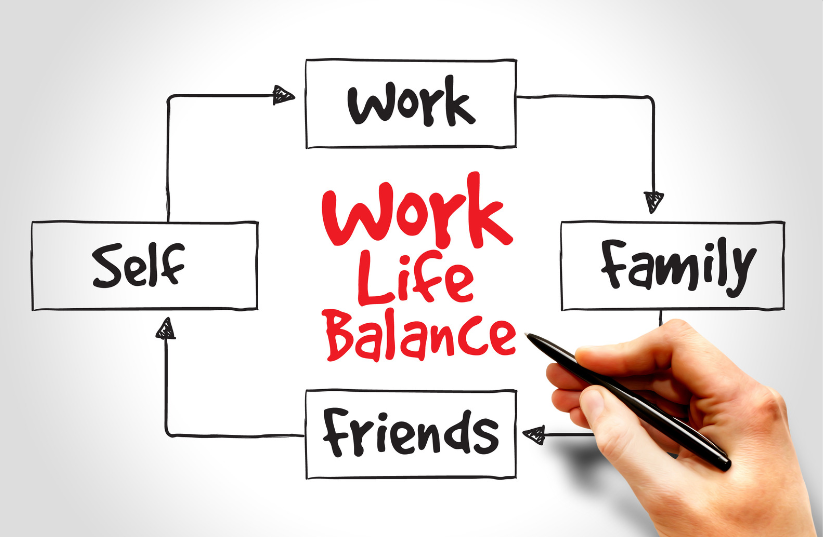How do you improve employee work-life balance? A Recipe for a Happier, More Productive Workforce.
Imagine a world where employees are happy and productive and where they have a healthy balance between their work and personal lives.
It may sound like a utopia, but it’s actually achievable.
By implementing a few simple strategies, employers can create a workplace that supports employee work-life balance and benefits everyone involved.
Here’s a metaphor: think of work-life balance as a recipe. Just like a good recipe, it requires the right ingredients in the right proportions. The key ingredients for work-life balance are:
- Flexible work arrangements
- Supportive management
- A culture of respect and well-being
When these ingredients are combined correctly, you can create a workplace that is both productive and supportive of employees’ needs.
In this article, we’ll explore each of these ingredients in more detail and provide tips on how to implement them in your own workplace. We’ll also share some examples of companies that are doing a great job of supporting employee work-life balance.
By the end of this article, you’ll have all the tools you need to create a workplace where your employees can thrive.
Ready to get started? Read on to learn more about how to improve employee work-life balance in your workplace.
What is work-life balance?

Work-life balance is the equilibrium between an individual’s professional commitments and personal life. It involves juggling one’s career, family, health, and personal pursuits effectively. Achieving a satisfying work-life balance is essential for overall well-being.
How Can You Improve Work-Life Balance?
Improving work-life balance in organization requires a multi-faceted approach. Here are some strategies to help employees find equilibrium:
Life Integration
Life integration involves seamlessly merging work and personal life. Encourage employees to intertwine their work responsibilities with their personal lives, such as attending family events or pursuing hobbies during flexible work hours.
Flexibility
Offering flexible work schedules allows employees to manage their time efficiently. This can reduce stress and improve satisfaction, as employees can accommodate their personal commitments.
Stress management techniques
Stress is a common workplace experience, but it can have a negative impact on employee productivity, satisfaction, and overall well-being. Employers can help employees manage stress by providing them with access to stress management techniques such as mindfulness and meditation. Mindfulness is the practice of paying attention to the present moment without judgment. Meditation is a focused practice that involves sitting quietly and focusing on your breath. Both mindfulness and meditation have been shown to be effective in reducing stress and improving mood.
Satisfaction
A positive work environment is essential for employee satisfaction. When employees feel valued and supported, they are more likely to be engaged in their work and have a better work-life balance. Employers can create a positive work environment by:
- Providing employees with clear expectations and feedback
- Creating opportunities for professional development
- Recognizing and rewarding employee contributions
- Fostering a culture of collaboration and respect
Time Strategies
Effective time management is essential for productivity and work-life balance. Employers can help employees develop effective time management skills by providing them with training on topics such as:
- Prioritization
- Goal setting
- Task management
- Time tracking
Employers can also provide employees with tools and resources to help them manage their time effectively, such as time-tracking software and project management tools.
Productivity
Many employees feel pressure to work long hours in order to be productive. However, research has shown that long working hours actually lead to decreased productivity. Employers can emphasize the importance of productivity over long working hours by:
- Setting realistic deadlines
- Encouraging employees to take breaks
- Providing employees with the resources they need to do their jobs effectively
Remote Work Policies

Remote work policies can provide employees with the flexibility to work from home or other locations. This can reduce commuting time and increase work-life balance. Employers can implement remote work policies by:
- Providing employees with the necessary equipment and software to work remotely
- Establishing clear communication and collaboration guidelines for remote workers
- Creating a culture of trust and accountability for remote workers
Workload Management
Employers need to monitor employee workloads to prevent burnout. Burnout is a state of emotional, physical, and mental exhaustion caused by prolonged or excessive stress. Employers can prevent burnout by:
- Ensuring that employee workloads are manageable
- Providing employees with the resources and support they need to complete their tasks
- Offering employees opportunities to take breaks and vacations
By taking these steps, employers can help employees manage stress, improve their work-life balance, and be more productive.
The importance of work-life balance
Work-life balance is not just a perk; it’s a fundamental necessity for both employees and employers. A harmonious work-life balance:
- Enhances employee well-being and mental health
- Boosts morale, job satisfaction, and overall happiness.
- Reduces turnover rates, leading to cost savings for companies.
- Increases productivity as employees are more focused and motivated.
Work-life balance strategies
To improve work-life balance, consider implementing these strategies within your organization:
- Conduct regular employee surveys to understand their needs and challenges.
- Promote a culture of flexibility and understanding within the workplace.
- Offer employee assistance programs that focus on well-being and mental health.
- Provide opportunities for professional development to reduce stress.
- Encourage regular breaks and vacations to prevent burnout.
Effective time management for employees

improves employee work-life balance with the best time tips. Effective time management is a key factor in achieving work-life balance. Employees can benefit from these time management techniques:
- Prioritize tasks based on urgency and importance.
- Set clear goals and expectations for each workday.
- Use technology to streamline work processes.
- Delegate tasks when necessary.
- Create boundaries between work and personal life.
Companies that are doing a great job of supporting employee work-life balance

improve employee work-life balance by example setting from other companies. Here are some examples of companies that are doing a great job of supporting employee work-life balance:
- Atlassian: Atlassian offers a variety of work-life balance benefits, including flexible work arrangements, unlimited paid time off, and a travel budget. The company also has a strong culture of respect and well-being, with a focus on employee mental health and happiness.
- Netflix: Netflix is known for its generous vacation policy, which allows employees to take as much time off as they need. The company also offers a variety of other work-life balance benefits, such as flexible work arrangements and parental leave.
- Google: Google offers a comprehensive package of work-life balance benefits, including flexible work arrangements, unlimited paid time off, and on-site childcare. The company also has a strong culture of innovation and collaboration, which helps to create a positive and supportive work environment.
- LinkedIn: LinkedIn offers a variety of work-life balance benefits, including flexible work arrangements, unlimited paid time off, and sabbaticals. The company also has a strong culture of diversity and inclusion, which helps to create a welcoming and supportive workplace for all employees.
Conclusion
In conclusion to our guide on how to improve employee work-life balance, improving employee work-life balance is a win-win situation. Employees lead happier, more fulfilled lives, and employers benefit from increased productivity and retention rates.
By incorporating flexibility, stress management, and effective time management into the workplace, you can help your employees strike a healthy work-life balance, which is essential for personal and professional success.
FAQs
Prioritize your tasks.
Set clear goals for work and personal life.
Utilize technology to streamline work processes.
Delegate tasks when necessary.
Create boundaries between work and personal life.
Work-life balance is important for both employees and employers. It leads to happier, more productive employees and cost savings for companies.
Work-life balance is essential for overall well-being, reducing stress, and enhancing job satisfaction. It also improves mental health and productivity.
By reducing stress, allowing employees to manage their time efficiently, and promoting a positive work environment, work-life balance leads to increased productivity.
While work-life balance is not the sole key to success, it is a critical factor in achieving personal and professional well-being and happiness.

